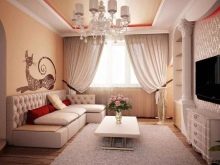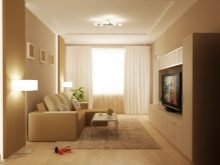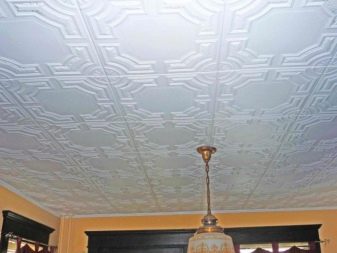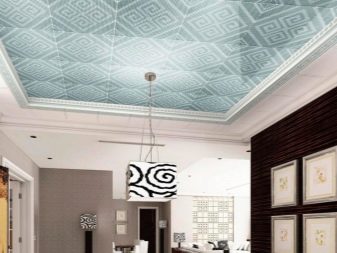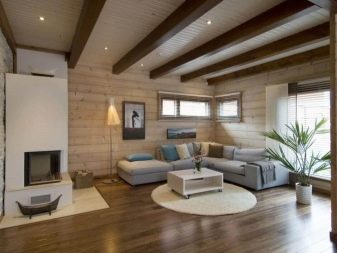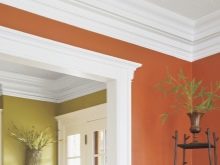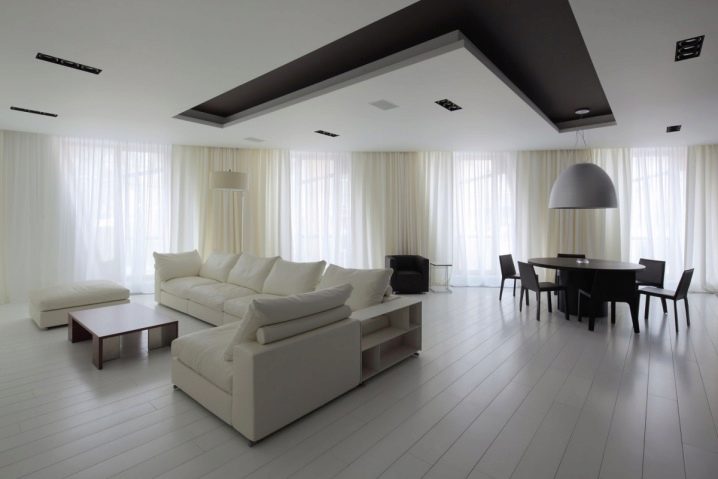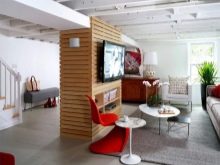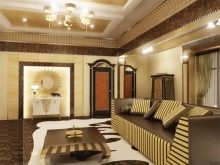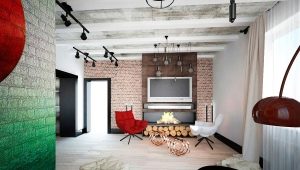The subtleties of the design of the ceiling in the living room

Having conceived the repair of the dwelling, it is difficult to ignore the issue of ceiling finishing. Today, the ceiling zone is a key element in the style of any room, through which you can convey the desired atmosphere. This is especially important for the living room - a place where all households gather. It is necessary to understand the subtleties of the design of the ceiling, given the different nuances.
Special features
The design of the ceiling directly depends on the design features of the room, its layout, the height of the walls, their symmetry. Often the broken prospect of the living room is an obstacle to the implementation of the idea. This is also hampered by insufficient footage, forcing to replace the planned ceiling design with a simpler composition.This is especially true for apartments of old layouts (Stalin, Khrushchev, Brezhnev). In most cases, the footage of their living room does not exceed 18 square meters. m, which puts significant limitations in the design of the ceiling zone.
Stalinki have a ceiling height of about 3 m, which allows you to perform frame construction, reducing the height of the walls. But in Khrushchev it is quite difficult to make a ceiling on a frame, “taking” 15 - 20 cm in height. When choosing the design of any ceiling, the key factor is the height of the walls - after finishing it should not be less than 2.3 m.
Otherwise, the atmosphere in the hall will be heavy, even if the style is based on light colors, a large number of squares, light furniture.
Determining the symmetry of the walls, they look at the accuracy of vertical planes: if the walls are visually curved, one is shorter than the other, some types of ceiling cannot be made, otherwise a noticeable decrease in the height of the walls may occur. In this case, it is better to do with a simpler design, or use the second level in a higher place on the ceiling.
Skewness of the walls matters, it can visually distort the entire ceiling composition, which significantly limits the design possibilities.
Kinds
To date, there are several types of installation of the ceiling.Designs are easy or complex, have their advantages and disadvantages, knowledge of which will allow you to choose the right option, taking into account the available tools and considerations of practicality. Some species are mounted directly on the base, others need a frame. All types can be divided into:
- single level;
- two-level;
- multilevel.
Each type has its own materials, features, type of raw materials used and the service life during which the ceiling looks neat and attractive.
Single level
This category includes ceilings, which represent a single level of the ceiling zone. At the same time, for an interesting design, it can be complemented by different lighting. This is a smooth ceiling with no steps, which can be smooth or embossed. It can differ in classical simple finishing (glue type) or frame (hinged type).
Duplex
This variety is characterized by the presence of two different levels of the ceiling zone: the plane of each level is different in height relative to the floor. More often, such constructions represent the design of the ceiling in the form of geometric figures on a flat plane or abstract parts of the construction of the second level.
Sometimes simple lines can be figured.These varieties are used where it is necessary to delimit the space of the hall into functional zones. At the same time, a sufficient ceiling height of at least 2.5 - 2.7 m is needed. The level of the second level depends on the design, the footage of the hall and the height of the walls.
Multilevel
This category includes ceilings with a particularly complex structure consisting of three or more levels. This can be a composition with a transition to walls or areas of different height for individual functional areas. A feature different from the two-tier variety is a greater number of steps with different heights in relation to the floor. By type of manufacturing such designs are different.
The most famous types of ceiling include:
- tension;
- suspended;
- rack and pinion;
- plasterboard (mirror);
- glue;
- raster (cassette);
- plastered;
- podshivnye.
Each ceiling covering is carried out using a certain technique.
Whitewashing and painting
The simplest types of work are whitewashing and painting. These methods today go by the wayside. They are used if financial possibilities are limited or if the style has certain requirements.Whitewashing is carried out by means of a spray gun or a brush, optionally adding color to the solution, and water-based and water-dispersion paints are used during painting. Both methods imply the need for perfect leveling of the base, otherwise all defects will be visible through the finishing materials.
Plaster
This type of finish is used in specific designs. Decorative plaster is applied after leveling the surface of the base and filling the cracks. At the same time, there are many ways of applying the material, which allows you to give the interior uniqueness. Such techniques are used in classic-style living rooms or when it is necessary to show elements of rustic themes, for example, in styles. Provence and Country.
Wallpapering
This adhesive ceiling finish method is more complicated than whitewashing and painting. The problem is that it is extremely inconvenient to glue strips to the ceiling with adhesive composition applied to the back side, especially if you use wide rolled varieties of material in your work.
The result is beautiful and even luxurious. For example, you can pick up material that will glow in the dark, creating the effect of the glow of stars.
However, the process cannot be called easy, because, in addition to thorough surface preparation, it requires constant stress, which is dangerous to health.
Ceiling tiles
One of the best budget options for facing the ceiling, which allows you to quickly enough to complete the ceiling zone. The material is woody, synthetic and metallic, which allows you to successfully enter this finish in the classic, modern, ethnic and vintage design directions.
Ceiling glue tiles, combining joints or performing pasting on seamless technology. This process is fast and allows you to carry out finishing work in just a day (excluding surface preparation).
Tensioner
This ceiling is made using a solid vinyl film or woven fabric, securing it with a plastic or metal profile that is placed under the ceiling itself. In the production of using ultrastrong polymers of minimum thickness (0.2 mm). Measurements for each ceiling are carried out individually.
To carry out finishing preferably with the help of professional craftsmen.
Cassette
A variation on a frame basis with fastening by means of plates from aluminum, or galvanized. The surface can be smooth, rough, have strips or notches. This design is easy to install, easy to remove to eliminate contamination, can be painted on the front surface of powder paint of different colors. Due to its resistance to fire, the ceiling allows the use of any lamps, but its sound insulation level is rather low.
Rack
These designs are installed in living rooms with high humidity. This ceiling, originally used in non-residential premises, is resistant to the effects of different temperatures and moisture. It is a canvas consisting of thin steel or aluminum plates coated with a special varnish of matte or glossy texture. The texture is different chrome, gold-plated, silver-plated surface type. Often the decor of such a ceiling are slats, which are installed specifically between the main plates.
Sewing
The ceiling on the basis of the frame of wood or metal. It is distinguished by relatively flexible parts, through which create a curved pattern of any complexity.The decoration uses sheet materials, including decorative panels.
This design allows you to decorate the ceiling area of the living room with a variety of lighting, excluding built-in appliances. At the same time, the finishing of the square is not carried out if there is communication wiring in it. This way of finishing the ceiling can not be carried out on the surface with significant curvature and defects.
Suspension
This type is a structure suspended from the ceiling by means of a frame. The frame can be made of wood or metal. At the same time use profiles (ceiling and guides), which are fastened around the perimeter of the ceiling. This system allows you to hide all defects of the primary ceiling.including communications. The design can be very diverse.
Gypsum plasterboard
This ceiling is included in the group of suspended structures. It is fixed by means of a galvanized steel frame. Its shape can be linear or curly (curvilinear). Plates that are good sound and heat insulation, at the final stage are subjected to finishing (for example, paint, put decorative plaster, paste over with wall-paper).
The covering is suitable only for a living room with a high ceiling, as it reduces to an average of 15 cm height. Gypsum board is successfully used in arched, domed, multi-level structures.
Finishing materials
Today, the construction market offers a lot of building materials to customers, through which you can finish the ceiling. Raw materials are selected taking into account the chosen style, for which the composition of the material is of particular importance (the concept requires the use of special materials suitable to it).
In modern areas various finishes are appropriate: metal, plastic, wallpaper, glass, mirror. Often in the interior you can see the laminated ceiling panels, decorated with the transition to the wall. Such accents look stylish and unique and allow you to zone the living room space, highlighting certain areas.
Ecological areas inherent in the use of natural raw materials. Wood panels, paper, cork, bamboo wallpapers are appropriate here. It is important to convey unity with nature, although designers recommend dosing the use of natural materials to give expressiveness.
For classics, you can use polystyrene foam tiles, which, after painting, accurately reproduces the effect of gypsum stucco molding. At the end of this style can be supplemented with a round decor at the base of the chandelier.
The choice of finishing materials for creative areas is unique: beams are bought for the ceiling, and at the same time they are connected with metal lights for communication elements. Often the ceiling trim is pipes combined with imitation of wooden beams. The combined reception allows you to achieve a unique effect: the ceiling with a rough finish in combination with a brick wall conveys the desired design atmosphere.
The paint is out of place here, because the glossy suspended ceiling looks better in a modern style, demonstrating the achievements of the latest technologies.
Depending on the chosen design idea, moldings, baguettes, ceiling plinth can be an additional ceiling finish. So you can give the finish a finished look and demonstrate the belonging of a room to a certain style. For example, elements with gilding will point to the classic direction.
The ceiling plinth with an ornament will allow to decorate a ceiling which facing was carried out by wall-paper, a ceiling tile, painting.These additions are able to highlight the combined type of ceiling decoration, when two different materials are used simultaneously (laying the ceiling tiles around the perimeter, the center of the ceiling can be decorated with wallpaper).
Lighting
Lighting in the living room should be as close to daylight as possible. This is important for proper perception, because the lack of light leads to internal discomfort. On the ceiling make out the central lamp. Depending on the footage, layout, zoning of the room, the central lighting device can be massive, multi-level or modest. It can be a separate accent or part of the lighting composition.
If the living room area allows, two lamps are placed on the ceiling. They can be made in the same style or placed in different functional areas of the hall. The main lamp is often hung over the guest area, and the auxiliary lighting is made in another part of the room. Lighting should emphasize the composition of the ceiling.Therefore, the décor of the devices is selected according to the specific design idea chosen.
In this additional lighting, if any, should not interrupt the central lighting.
Often, spotlights are used in the lighting composition.Today they are an obligatory component of the ceiling zone of modern interior styles. Due to modern light sources, the tone of illumination can be brought closer to the natural (day) light. At the same time it will be harmless to health (LEDs do not emit toxins). Such stylish and beautiful lamps without too much decoration are ways to successfully support the desired design idea.
Styles
The design of the ceiling depends on the chosen style. Conventionally, all types of design can be divided into classic, modern, ethnic and vintage styles. The first group includes the classic Neoclassicism, classicism, Italian styles. By the style of design you can add to them English style. The ceiling can be multi-layered or simple (depending on the height), and the presence of gypsum stucco or its imitation is mandatory.
In modern directions important to demonstrate the latest materials and their capabilities. Be sure to highlight the backlight, which can be a classic or built-in type. The ceiling can have a glossy or matte surface, be equipped with a complex composite lighting, including a large main lamp with a closed canopy and additional lighting.At the same time, often point or linear LED lamps are arranged along straight or curved lines of a certain level, deliberately separating it from another level.
Ethnic Destinations They combine different techniques, quite often quite relevant modern notes are noticeable in the design of the ceiling. When making the ceiling attached importance to the number of pieces of furniture and accessories. For example, if there is a lot of space in the living room, there is a dining area, but the room is not crowded with trifles, a multi-level ceiling construction is allowed.
If the interior is initially replete with fine details, it is necessary to limit the pomp of the ceiling decor. It is not so important which style was taken as the basis.
The design is thought out at the initial stage of repair. If this design is a two-level living room, you can make a multi-level ceiling with a mass of LEDs, highlighting each area of the room. If this is a living room with a bay window (semi-circular, faceted, cubic, rectangular shaped glazed projection), you can make your own design for each zone with different levels of wall height, taking into account the functionality of different parts of the room.For example, if the bay window will be used for dining space, you can choose a composition with a hanging chandelier, decorating the ceiling with stucco.
If there is a recreation area in this place, you can leave the ceiling united by beating different zones with lamps of various types, including built-in ones.
Colors and decor
Any color and decor of the ceiling depends on the specific style and footage of the living room. If the space is extensive, then saturated colors of the color palette are allowed. However, unnecessarily bright colors are unacceptable, because the living room needs soothing shades that would maintain a relaxing atmosphere. In order not to be mistaken, it is worth choosing light colors of pastel scale, excluding rich pink shades, which can cause discomfort in a strong half of humanity.
The ideal colors of the ceiling are white, milky, light blue, bleached wenge, light gray or beige. When the height of the ceiling and the living room footage allow, you can combine the dominant light tone with rich contrast. This bright color should not be much, because it can interrupt all the attention that is unacceptable for the composition in the interior.
It is desirable that in the design of the ceiling was white, it will add any room light, lightness and airiness, visually make the ceiling high. In the absence of it, the walls appear lower, even if light tones are chosen as the base, and the main interior is made in dark colors.
It is undesirable to use a mirrored ceiling in the living room, which would deprive the design of harmony and comfort. The abundance of black is unacceptable if a monochrome design is chosen as the stylistic idea. No matter how original the design, the black tint will subconsciously put pressure on the household or incoming guests, forcing them to leave the room. If there is not enough dark color for expressiveness, it is more expedient to supplement the finish of the main color with a brown or bronze tone in a small amount.
Decor
The decoration of the ceiling is subject to the chosen style. If this is minimalism, almost all decorative elements are excluded. It is important to emphasize the texture of the material, which is a gloss or a game of almost imperceptible contrast when using two shades of the color palette.In the directions for which decorative elements are characteristic, it is allowed to use matte or glossy texture with various prints.
The size of the picture, its subject matter depends on the specific style and its lines, for example, if it is country, floral ornaments are allowed.
In the modern style for the ceiling use unique materials with a 3D effect, allowing you to visually increase the amount of space. It can be a mirror tile, which consists of metal or plastic and has small mirror inserts on the relief surface. In some cases, the ceiling is decorated with drawings, or special stickers to make the interior special, beat each built-in lamp, which is another element of the ceiling decoration.
At the same time, the size of the lamps must correspond to the ceiling area, otherwise the harmony of the design may be disturbed.
Beautiful examples in the interior
To see how beautiful and harmonious the design of the living room ceiling can be, you can look at Interesting examples from the presented photo gallery:
- The ceiling with beams fits perfectly into eclecticism, combining design elements of the old and new times.
- The two-level ceiling with white trim is in harmony with the antique direction, having a central hanging lamp and spot lighting.
- The strict lines of the multi-level ceiling look good in the classic style of the living room, observing some restraint.
- The original way to decorate the ceiling is to transfer the accent of the ceiling surface to the accent plane of the video zone. This option fits well with modern styles.
- The open-plan living room looks stylish, because the white ceiling with uncluttered lines and patterned lighting gives the interior completeness.
- A concise option would be to use a multi-level design to highlight the guest area.
- A two-tier ceiling composition in beige and white tones balances the rich shades of the furnishings.
How to make a ceiling with your own hands, you can learn from the video below.



